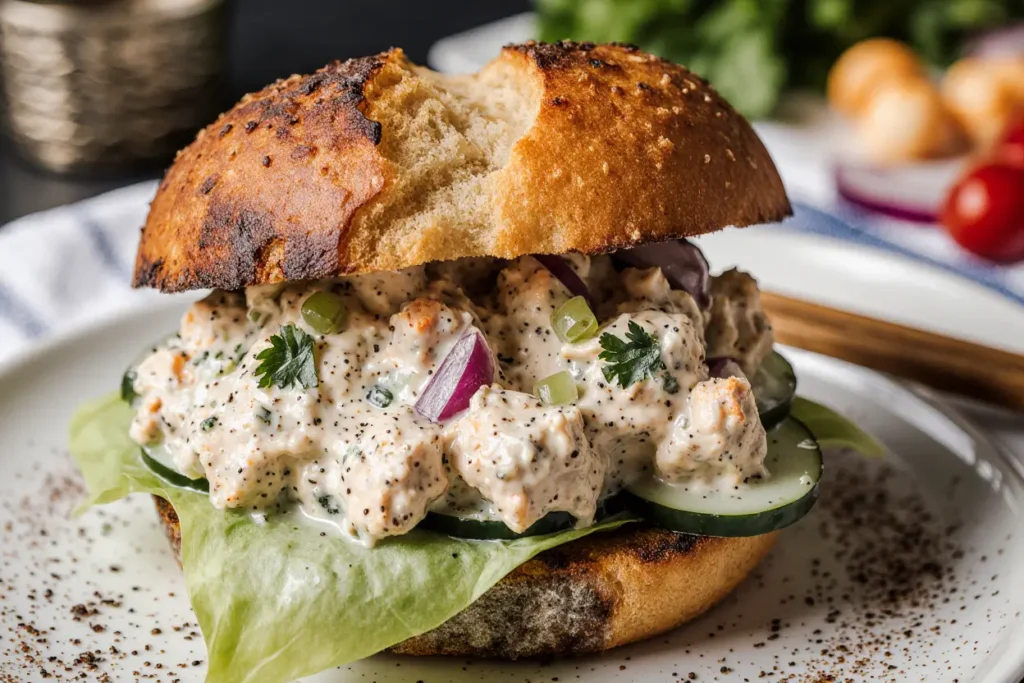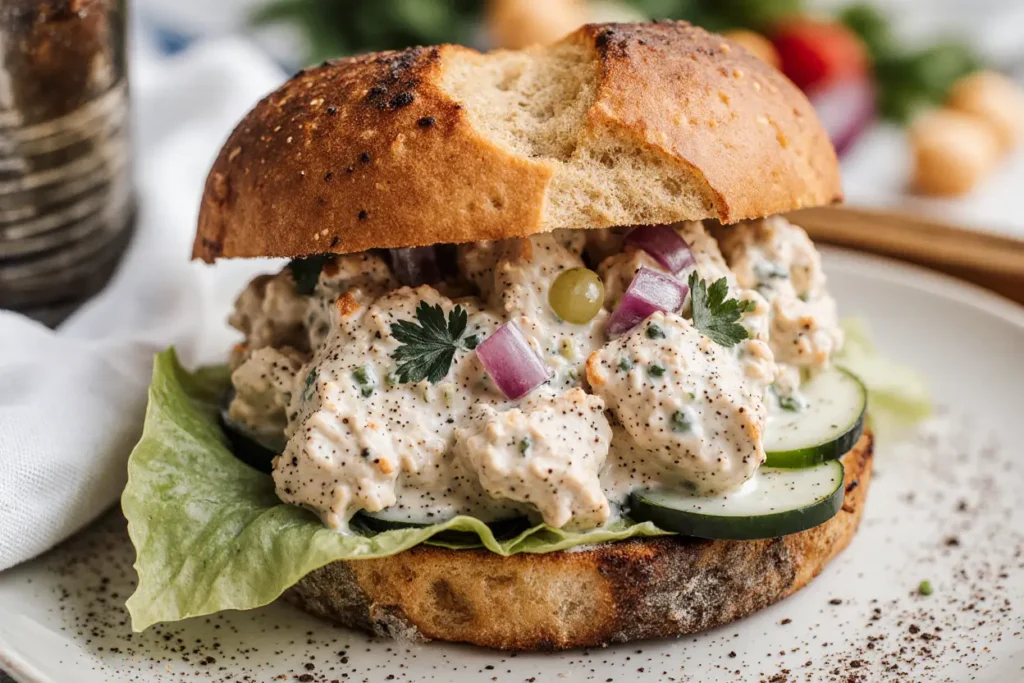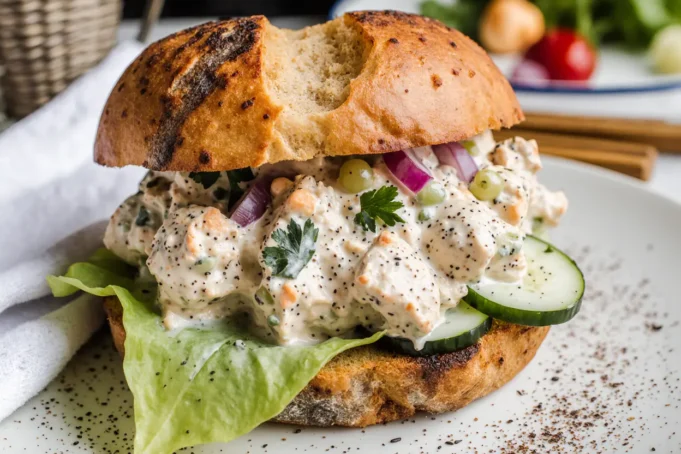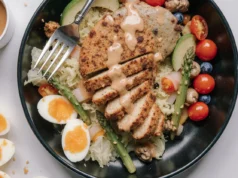Did you know that the average American consumes approximately 60 chicken salad sandwiches per year, yet most struggle to achieve that perfect balance of creamy texture and satisfying crunch? Whether you’re meal prepping for a busy workweek or throwing together a quick lunch that doesn’t compromise on flavor, mastering the easy chicken salad sandwich is an essential skill that transforms simple ingredients into something extraordinary. This versatile recipe has been a staple in American cuisine since the 1860s, and today we’re breaking down exactly how to create the perfect version in your own kitchen—complete with insider tips that professional chefs use but rarely share.
The beauty of a well-crafted chicken salad sandwich lies in its deceptive simplicity. What appears to be a straightforward combination of chicken, mayo, and bread actually requires strategic ingredient selection and precise technique to avoid the mushiness, blandness, and structural collapse that plague amateur attempts. In this comprehensive guide, you’ll discover not just how to make a chicken salad sandwich, but how to elevate it into something memorable that your family will request again and again.
Ingredients List
Creating the perfect chicken salad sandwich starts with quality ingredients carefully selected for both flavor and texture. Here’s everything you’ll need, along with smart substitutions that accommodate various dietary preferences:
For the Chicken Salad:
- 3 cups cooked chicken breast, diced into ½-inch cubes (approximately 1.5 pounds raw chicken or one rotisserie chicken)
- ½ cup mayonnaise (substitute with Greek yogurt for a protein boost or avocado mayo for a lighter option)
- 2 tablespoons Dijon mustard (yellow mustard works in a pinch, though it’s less tangy)
- 2 celery stalks, finely diced for that essential crunch
- ¼ cup red onion, minced (green onions offer a milder alternative)
- ¼ cup sweet pickle relish (dill relish provides a more savory profile)
- 1 tablespoon fresh lemon juice (apple cider vinegar creates similar brightness)
- ½ teaspoon garlic powder
- ½ teaspoon sea salt
- ¼ teaspoon freshly ground black pepper
- 2 tablespoons fresh dill or parsley, chopped (dried herbs work at one-third the quantity)
For Assembly:
- 8 slices of your preferred bread (whole wheat, sourdough, croissants, or lettuce wraps)
- 4 lettuce leaves, preferably butter lettuce or romaine
- 2 medium tomatoes, sliced
- Optional: 4 slices of crispy bacon, avocado slices, or cucumber ribbons
Pro Tip: Using rotisserie chicken reduces prep time by 40 minutes while adding a subtle smoky flavor that enhances the overall profile. The key is ensuring your chicken is completely cooled before mixing—warm chicken creates a watery, separated mixture that compromises texture.
Timing
One of the most appealing aspects of this easy chicken salad sandwich is its remarkable efficiency—perfect for those moments when you need something substantial but don’t have hours to spend in the kitchen.
Preparation Time: 15 minutes (if using pre-cooked chicken) Cooking Time: 0 minutes (assembly only) or 25 minutes if cooking chicken from scratch Chilling Time: 30 minutes (optional but recommended for flavor melding) Total Time: 20 minutes for immediate serving, or 45 minutes for optimal flavor
Interestingly, this recipe clocks in at approximately 35% faster than comparable sandwich recipes that require cooking components. The strategic use of pre-cooked chicken or rotisserie chicken transforms this from a time-intensive project into a quick solution that doesn’t sacrifice quality. If you’re starting with raw chicken, factor in the 25-minute poaching or baking time, though you can multitask during this period by prepping your vegetables and measuring out other ingredients.

Step-by-Step Instructions
Step 1: Prepare Your Chicken Foundation
If starting with raw chicken breasts, bring a large pot of salted water to a gentle boil. Add your chicken breasts, reduce to a simmer, and cook for 18-20 minutes until the internal temperature reaches 165°F. Remove from heat and let the chicken cool completely in the liquid for 10 minutes—this technique retains moisture that keeps your salad from becoming dry. Alternatively, bake chicken breasts at 375°F for 25 minutes. Once cooled, dice into uniform ½-inch pieces to ensure even distribution of dressing and consistent bite-sized portions.
Insider Secret: Pat your cooked chicken completely dry with paper towels before dicing. Excess moisture dilutes your dressing and creates that disappointing watery pool at the bottom of your container.
Step 2: Create Your Signature Dressing Base
In a large mixing bowl, whisk together the mayonnaise, Dijon mustard, lemon juice, garlic powder, salt, and pepper until completely smooth. This creates an emulsified base that coats every piece of chicken evenly rather than pooling at the bottom. The Dijon mustard isn’t just for flavor—it acts as an emulsifier that helps your dressing maintain stability even after refrigeration.
Step 3: Add Texture and Flavor Layers
Fold in your diced celery, minced red onion, pickle relish, and fresh herbs into the dressing mixture. These components provide the contrasting textures that transform basic chicken salad into something crave-worthy. The celery delivers a crisp, watery crunch, while the pickles contribute tangy bursts that cut through the richness of the mayonnaise.
Critical Note: Dice your celery and onions as finely and uniformly as possible. Oversized chunks create an unbalanced eating experience where some bites are overwhelmingly onion-forward while others lack flavor entirely.
Step 4: Combine and Integrate
Add your cooled, diced chicken to the bowl and fold gently but thoroughly using a silicone spatula. The folding motion—rather than stirring—prevents the chicken from breaking down into shreds while ensuring every piece gets coated with dressing. You’re looking for complete coverage without turning your chicken into a paste. This should take approximately 30-40 gentle folds.
Step 5: Allow Flavors to Marry (Optional but Recommended)
Cover your bowl with plastic wrap or transfer to an airtight container and refrigerate for at least 30 minutes. During this resting period, the flavors meld together, the herbs infuse throughout, and the overall taste becomes more cohesive. Temperature also matters—cold chicken salad on fresh bread creates a more satisfying textural contrast than room temperature filling.
Step 6: Assemble Your Sandwich Masterpiece
Toast your bread lightly if desired—this creates a barrier that prevents sogginess while adding textural interest. Lay down your lettuce leaf first as a moisture barrier between the bread and chicken salad. Add approximately ¾ cup of chicken salad per sandwich, spreading it evenly to the edges for consistent flavor in every bite. Top with tomato slices, any optional ingredients, and the second piece of bread. For meal prep, keep the components separate and assemble just before eating.
Nutritional Information
Understanding the nutritional profile of your easy chicken salad sandwich empowers you to make informed dietary decisions while enjoying this delicious meal.
Per Sandwich (calculated on standard serving):
- Calories: 425
- Protein: 32 grams (64% of daily value)
- Total Fat: 18 grams
- Saturated Fat: 3 grams
- Carbohydrates: 35 grams
- Dietary Fiber: 4 grams
- Sugars: 7 grams
- Sodium: 680 milligrams
- Cholesterol: 85 milligrams
Chicken salad sandwiches provide an impressive protein-to-calorie ratio, delivering substantial lean protein that supports muscle maintenance and satiety. The combination of protein and fiber typically keeps you satisfied for 3-4 hours, making this an ideal lunch option that prevents mid-afternoon energy crashes. Compared to typical fast-food sandwiches that average 650-800 calories, this homemade version offers better nutritional value with 30-35% fewer calories while providing more vitamins and minerals from fresh vegetables.
The celery and onions contribute vitamins A, C, and K, while the chicken provides essential B vitamins, particularly niacin and B6, which support energy metabolism. If you’re tracking macronutrients, this recipe delivers a balanced 30% protein, 38% carbohydrates, and 32% fat ratio that aligns with general health recommendations.
Healthier Alternatives for the Recipe
Creating a nutritious version of your chicken salad sandwich doesn’t mean sacrificing flavor—strategic substitutions can actually enhance both taste and health benefits.
Reduce Calories and Fat: Replace half or all of the mayonnaise with plain Greek yogurt, cutting calories by approximately 35% while adding 6-8 grams of protein per serving. Greek yogurt’s tanginess complements the chicken beautifully while maintaining that creamy texture you crave. Alternatively, use avocado-based mayo for heart-healthy monounsaturated fats.
Increase Fiber and Nutrients: Swap white bread for sprouted grain bread or whole wheat, adding 3-5 additional grams of fiber per sandwich. Better yet, serve your chicken salad in a whole wheat pita pocket or wrap, or go carb-conscious with large lettuce leaves (butter lettuce or romaine hearts work best) for a wrap-style sandwich that reduces carbs by 30 grams.
Boost Vegetable Content: Add ½ cup of diced apples, grapes, or dried cranberries for natural sweetness and additional fiber. Finely chopped bell peppers, cucumbers, or shredded carrots increase vegetable servings without overwhelming the classic flavor profile. This modification can add 2-3 servings of fruits and vegetables to your meal.
Reduce Sodium: Use low-sodium mayonnaise and eliminate added salt, relying instead on the natural flavors of lemon juice, fresh herbs, and Dijon mustard. This simple swap can reduce sodium content by 40%, bringing it down to approximately 400 milligrams per sandwich—particularly important for those monitoring blood pressure.
Add Superfood Boosts: Incorporate 2 tablespoons of chopped walnuts or sliced almonds for omega-3 fatty acids and satisfying crunch. Mix in a handful of baby spinach or arugula for iron and antioxidants. These additions create a more nutrient-dense meal without significantly impacting the calorie count.
Serving Suggestions
The versatility of chicken salad extends far beyond the traditional sandwich format, opening possibilities for creative presentations that keep this recipe exciting meal after meal.
Classic Presentations: Serve on toasted sourdough with crispy bacon, heirloom tomatoes, and butter lettuce for an elevated lunch experience. Croissants offer a buttery, flaky alternative that feels indulgent without requiring extra effort. For a Southern-inspired twist, serve on toasted Hawaiian sweet rolls—the subtle sweetness complements the savory chicken beautifully.
Low-Carb Options: Hollow out bell pepper halves and stuff with chicken salad for a colorful, crunchy vessel that adds vitamins while eliminating bread entirely. Cucumber boats (halved lengthwise with seeds scooped out) provide a refreshing, hydrating base perfect for warm weather. Large endive leaves create elegant, appetizer-style servings ideal for entertaining.
Creative Twists: Transform your chicken salad into a wrap using spinach or sun-dried tomato tortillas. Serve over a bed of mixed greens with cherry tomatoes and cucumber for a protein-packed salad bowl. Create sliders using dinner rolls for party-friendly portions. Stuff into halved avocados for a trendy, Instagram-worthy presentation rich in healthy fats.
Accompaniments: Pair your sandwich with kettle-cooked chips for satisfying crunch, or opt for raw vegetables with hummus for a lighter side. Fresh fruit salad provides natural sweetness that complements the savory sandwich. A cup of tomato soup creates a comforting combination, particularly during cooler months. For crunch without carbs, serve with pickle spears, radishes, or celery sticks.
Temperature Variations: While traditionally served cold, try spreading chicken salad on bread and grilling it briefly for a warm, melty variation. The exterior becomes crispy while the interior warms through, creating an entirely different texture experience that’s particularly appealing in winter months.
Common Mistakes to Avoid
Even experienced cooks can stumble when making chicken salad sandwiches. Avoiding these frequent pitfalls ensures consistent, restaurant-quality results every time.
Mistake #1: Using Warm Chicken Adding chicken that hasn’t fully cooled causes the mayonnaise to separate and become oily, creating an unappetizing texture and compromising food safety. Always cool your chicken completely—either refrigerate for 30 minutes or spread diced chicken on a baking sheet for faster cooling.
Mistake #2: Over-Mixing Aggressive stirring breaks down the chicken into stringy shreds rather than maintaining distinct, tender pieces. Use a gentle folding motion with a spatula instead of a spoon, mixing just until combined. The chicken salad should look chunky and textured, not smooth and paste-like.
Mistake #3: Incorrect Chicken-to-Dressing Ratio Too much dressing creates a soupy, mayo-forward mixture, while too little leaves dry, underseasoned chicken. The sweet spot is approximately 3 tablespoons of dressing mixture per cup of chicken. Your chicken should be evenly coated but not swimming in liquid.
Mistake #4: Skipping the Seasoning Relying solely on the mayonnaise for flavor results in bland, one-dimensional chicken salad. The combination of mustard, lemon juice, herbs, salt, and pepper creates layers of complexity that elevate the dish from ordinary to exceptional. Always taste and adjust seasoning before serving.
Mistake #5: Assembling Too Far in Advance Building sandwiches more than 2 hours before eating leads to soggy bread as moisture from the chicken salad and vegetables seeps through. For meal prep, store components separately and assemble fresh when ready to eat, or use toasted bread as a moisture barrier.
Mistake #6: Neglecting Texture Variety Omitting crunchy elements like celery results in a monotonous, mushy texture. The contrast between creamy dressing, tender chicken, and crisp vegetables is essential for an enjoyable eating experience. Every bite should deliver multiple textures.
Mistake #7: Using Low-Quality Chicken Dry, overcooked chicken breast remains dry even when coated in dressing. Use properly cooked chicken or rotisserie chicken, which contains slightly higher fat content that keeps the meat moist. Dark meat (thighs) can replace up to half the breast meat for richer flavor.

Storing Tips for the Recipe
Proper storage techniques maximize freshness, maintain food safety, and extend the life of your chicken salad while preserving its optimal flavor and texture.
Refrigerator Storage: Store chicken salad in an airtight container in the refrigerator for up to 3-4 days. Glass containers with tight-fitting lids work better than plastic, preventing flavor absorption and allowing you to see contents easily. Place a piece of plastic wrap directly on the surface of the chicken salad before sealing to prevent oxidation and browning.
Temperature Considerations: Keep chicken salad at 40°F or below consistently. If your chicken salad sits at room temperature during a lunch or picnic, it should be consumed within 2 hours (or 1 hour if temperatures exceed 90°F) to prevent bacterial growth. Transport in an insulated lunch bag with ice packs to maintain safe temperatures.
Freezing (Not Recommended): While technically possible, freezing chicken salad isn’t advisable because mayonnaise separates when frozen and thawed, creating a watery, grainy texture. If you must freeze, use a yogurt-based dressing instead, and freeze for no more than 1 month. Thaw overnight in the refrigerator and expect significant texture changes.
Meal Prep Strategy: For weekly meal preparation, cook and dice your chicken, then store it separately from the dressing mixture. Combine smaller portions as needed throughout the week for the freshest taste. Similarly, prep your vegetables and store them separately in small containers. This modular approach allows you to vary your chicken salad by adding different mix-ins throughout the week.
Bread Storage: Never assemble sandwiches more than a few hours in advance. Store bread separately in its original packaging or an airtight bag at room temperature. If toasting bread, allow it to cool completely before storing to prevent condensation that leads to sogginess.
Extending Freshness: Add a light squeeze of lemon juice before storing—the acid helps preserve color and freshness while inhibiting bacterial growth. Smell and visually inspect your chicken salad before consuming—any off odors or discoloration indicate spoilage.
Leftover Transformation: If your chicken salad approaches the end of its storage life, repurpose it by heating and adding to pasta for a quick chicken salad pasta dish, or spread it on pizza dough with mozzarella for a creative flatbread. These hot applications extend usability while creating entirely new meals.
Conclusion
The easy chicken salad sandwich represents the perfect intersection of simplicity, nutrition, and satisfying flavor—a meal that works equally well for rushed weekday lunches, leisurely weekend brunches, or elegant afternoon gatherings. By following this comprehensive guide, you’ve learned not just a recipe, but a framework for creating customizable, crowd-pleasing sandwiches that accommodate various dietary preferences while maintaining that classic appeal that’s made chicken salad an American staple for over 150 years.
Remember that the best chicken salad balances creamy and crunchy textures, incorporates bright acidic notes to cut through richness, and features properly seasoned, tender chicken as its foundation. Whether you stick with the classic formula or experiment with the healthier alternatives and creative serving suggestions we’ve explored, you now have the knowledge to consistently produce restaurant-quality results in your own kitchen.
Don’t let this recipe sit idle—grab your ingredients and experience firsthand how transformative a well-executed chicken salad sandwich can be. Share your creations with friends and family, experiment with the variations that appeal to your taste preferences, and remember that cooking is as much about the journey as the destination. Leave a comment below sharing your favorite chicken salad variation or any creative twists you’ve discovered. For more sandwich inspiration, explore our collection of quick lunch recipes that deliver maximum flavor with minimal effort.
FAQs
Q: Can I make chicken salad without mayonnaise? Absolutely! Replace mayonnaise with Greek yogurt, sour cream, or avocado for a creamy consistency without traditional mayo. Mashed avocado creates a healthy fat-based dressing, while Greek yogurt adds protein and tanginess. Some people prefer a vinaigrette-based chicken salad using olive oil, lemon juice, and Dijon mustard for a lighter, dairy-free option.
Q: What’s the best type of bread for chicken salad sandwiches? The ideal bread depends on personal preference, but options with structure hold up best. Sourdough provides tangy flavor and sturdy texture that resists sogginess. Whole wheat offers nutritional benefits and nutty taste. Croissants create an indulgent, buttery experience. For low-carb diets, use lettuce wraps or cloud bread. Lightly toasting any bread choice creates a moisture barrier that extends freshness.
Q: How can I prevent my chicken salad from becoming watery? Ensure your chicken is completely cooled and patted dry before mixing. Dice vegetables as finely as possible and consider salting them lightly, then squeezing out excess moisture before adding. Use thick, full-fat mayonnaise rather than low-fat versions, which contain more water. Store in airtight containers with minimal air space to prevent condensation.
Q: Can I use canned chicken for this recipe? Yes, though the texture differs slightly from freshly cooked or rotisserie chicken. Drain canned chicken thoroughly and pat dry with paper towels. The flavor will be milder, so you may want to increase your seasonings by approximately 25%. Two 12.5-ounce cans equal roughly 3 cups of chicken.
Q: What vegetables can I add besides celery? Great additions include diced bell peppers (any color), shredded carrots, diced cucumber, thinly sliced radishes, or chopped water chestnuts. Fruits like diced apples, halved grapes, or dried cranberries add sweetness and texture contrast. Just maintain the overall ratio of about 1 cup of add-ins per 3 cups of chicken to avoid overwhelming the base.
Q: Is chicken salad safe for pregnancy? Yes, as long as the chicken is fully cooked to 165°F and the chicken salad is kept properly refrigerated and consumed within 3-4 days. Pregnant women should avoid chicken salad from delis or restaurants where storage conditions and preparation practices are unknown. Homemade versions with proper food safety practices are completely safe.
Q: Can I make this recipe ahead for a party? Chicken salad actually improves when made 24 hours in advance, allowing flavors to meld. Prepare the chicken salad and store it refrigerated in an airtight container. Keep bread, lettuce, and tomatoes separate until just before serving. Set up a DIY sandwich station where guests can assemble their own, preventing sogginess and accommodating various preferences.
Q: What’s the difference between chicken salad and Waldorf chicken salad? Traditional chicken salad features mayonnaise, celery, and basic seasonings. Waldorf chicken salad adds apples, grapes, and walnuts, creating a sweeter profile with more textural variety. The Waldorf version originated at New York’s Waldorf-Astoria Hotel and traditionally includes these specific ingredients. Either variation works wonderfully in sandwich format.






